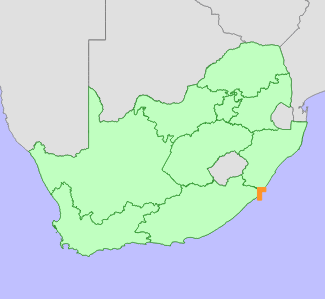|
Scientific Name | Eriosema umtamvunense C.H.Stirt. |
Higher Classification | Dicotyledons |
Family | FABACEAE |
National Status |
Status and Criteria | Endangered A2c |
Assessment Date | 2014/08/08 |
Assessor(s) | L. von Staden |
Justification | At least a 50% population reduction is inferred from the rate of rapid, ongoing habitat loss within the last three generations of this long-lived, suffrutescent grassland forb (generation length 30-50 years). |
Distribution |
Endemism | South African endemic |
Provincial distribution | Eastern Cape, KwaZulu-Natal |
Range | KwaZulu-Natal south coast, from Margate to the Mzamba River, in the Eastern Cape south of Port Edward. |
Habitat and Ecology |
Major system | Terrestrial |
Major habitats | Pondoland-Ugu Sandstone Coastal Sourveld |
Description | Pondoland coastal grasslands, Msikaba Formation Sandstone, 50-600 m. |
Threats |
| About 60% of the grasslands within the known range of this locally common, long-lived suffrutescent grassland forb is already irreversibly modified, as a result of expanding cultivation of sugarcane, bananas and macadamia nuts, as well as forestry plantations and the urban expansion on the coast between Port Edward and Margate. Grasslands are continuously being rapidly lost and degraded, predominantly due to a significant increase in the extent of densely populated rural settlements and associated subsistence agriculture, as well as coastal development, over the past 20 years. Remaining grasslands outside protected areas are also subjected to overgrazing and inappropriate fire management. |
Population |
Eriosema umtamvunense is locally common in suitable habitat, however, the population has become fragmented due to extensive habitat loss. Recent survey data indicates that this species is more widespread than previously known, although the range is still very restricted. By the 1990s, it had already lost at least 40% of its habitat, and a comparison of recent and historic land cover data indicates that loss is continuing rapidly, with another 30% lost within 15 years, and less than 40% of this species' original habitat now remains intact. It is a long-lived, slow growing, resprouting forb (generation length estimated 30-50 years), and from the rapid rate of habitat loss a population reduction of at least 50% over the past three generations is inferred.
|
Population trend | Decreasing |
Conservation |
| Umtamvuna Nature Reserve. |
Assessment History |
Taxon assessed |
Status and Criteria |
Citation/Red List version | | Eriosema umtamvunense C.H.Stirt. | EN A2c | 2015.1 | | Eriosema umtamvunense C.H.Stirt. | VU A2c | Raimondo et al. (2009) | | Eriosema umtamvunense C.H.Stirt. | Lower Risk - Near Threatened | Scott-Shaw (1999) | | Eriosema umtamvunense C.H.Stirt. | Rare | Hilton-Taylor (1996) | |
Bibliography |
Abbott, A., Van Wyk, A.E., Johnson, D.N. and Scott-Shaw, C.R. 2000. Checklist of the macrofungi, lichens, bryophytes and vascular plants of the Umtamvuna Nature Reserve, South Africa. Lammergeyer 46:1-69.
Hilton-Taylor, C. 1996. Red data list of southern African plants. Strelitzia 4. South African National Botanical Institute, Pretoria.
Raimondo, D., von Staden, L., Foden, W., Victor, J.E., Helme, N.A., Turner, R.C., Kamundi, D.A. and Manyama, P.A. 2009. Red List of South African Plants. Strelitzia 25. South African National Biodiversity Institute, Pretoria.
Scott-Shaw, C.R. 1999. Rare and threatened plants of KwaZulu-Natal and neighbouring regions. KwaZulu-Natal Nature Conservation Service, Pietermaritzburg.
Stirton, C.H. 1986. The Eriosema squarrosum complex (Papilionoideae, Fabaceae) in southern Africa. Bothalia 16(1):11-22.
|
Citation |
| von Staden, L. 2014. Eriosema umtamvunense C.H.Stirt. National Assessment: Red List of South African Plants version . Accessed on 2025/06/01 |
 Comment on this assessment
Comment on this assessment


